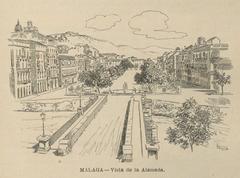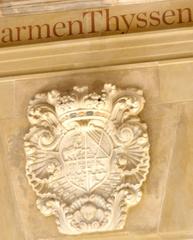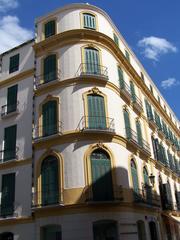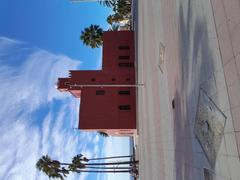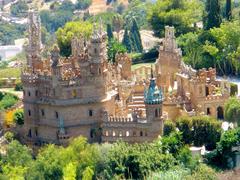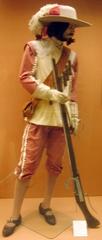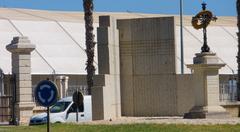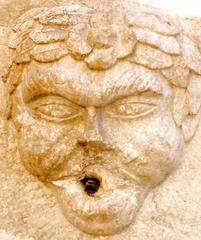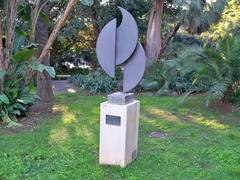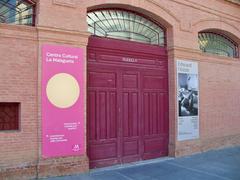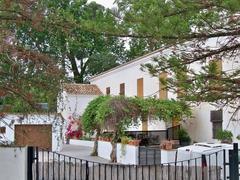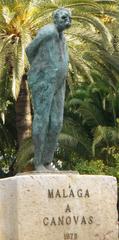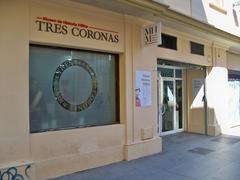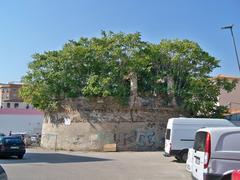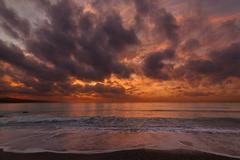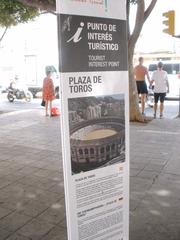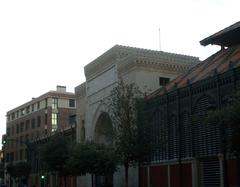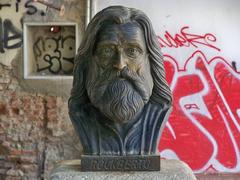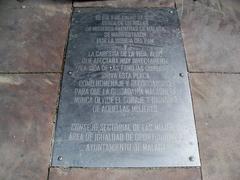
Comprehensive Guide to Visiting Málaga, Málaga Province, Spain
Date: 14/08/2024
Captivating Introduction
Welcome to Málaga, a city where every cobblestone whispers tales of ancient civilizations and every sunbeam dances on the waves of the Mediterranean. Imagine a place where prehistoric art from the Cueva de la Pileta dates back 42,000 years, mingles with the Phoenician-founded streets of Malaka from 770 BC, and the Roman Theatre invites you to sit and envision gladiatorial spectacles (Wikipedia; Britannica). Málaga isn’t just a city; it’s a living, breathing tapestry woven from centuries of conquests, cultural exchanges, and artistic brilliance. Picture yourself wandering through Moorish fortresses like the Alcazaba and Gibralfaro Castle, standing tall since the 11th and 14th centuries, and marveling at the Renaissance beauty of La Manquita Cathedral (Wikipedia; Britannica; Hey Explorer). As the birthplace of Pablo Picasso, Málaga’s vibrant art scene is etched into its very soul, with museums like the Picasso Museum and Centre Pompidou Málaga showcasing both classic and contemporary works (PlanetWare; Visit Andalucia). Whether you’re here for the sun-soaked beaches or the rich historical tapestry, Málaga promises an adventure for every traveler. Let’s embark on this journey together, discovering hidden gems, savoring local flavors, and immersing ourselves in the magic of Málaga.
Table of Contents
- Discovering Málaga: A Mosaic of History and Culture
- Visitor Tips
- Attractions
- Practical Information
- Málaga Magic: Your Insider’s Guide to the Jewel of Spain
- Call to Action
Discovering Málaga: A Mosaic of History and Culture
Prehistoric and Ancient Settlements
Imagine wandering through a city where each corner tells a tale older than your grandmother’s favorite recipe! The region now known as Málaga has been inhabited since prehistoric times. Picture this: cave paintings in the Cueva de la Pileta and ancient artifacts at the Dolmen of Menga near Antequera and the Cueva del Tesoro near Rincón de la Victoria. These findings whisper secrets from the Paleolithic era, with some paintings even attributed to Neanderthals dating back approximately 42,000 years.
Phoenician Foundation
Did you know Málaga’s recorded history begins with the Phoenicians, who founded the city around 770 BC? They named it “Malaka,” which likely means “fish salting place”—a nod to the city’s early economic activities (Wikipedia). Imagine the bustling trade routes they established, making Malaka a trading post gem on the Mediterranean coast.
Carthaginian and Roman Rule
Fast forward to the 6th century BC, and Málaga falls under Carthaginian control until the Roman Republic takes over in 218 BC during the Punic Wars (Malaga.com). Under Roman rule, Málaga, known as “Malaca,” flourishes. Picture the city thriving on the production of garum, a fermented fish sauce that was the ketchup of Roman cuisine. The special municipal code, the Lex Flavia Malacitana, even granted its free-born inhabitants Roman citizenship privileges (Wikipedia).
Visigothic and Byzantine Periods
Around 411 AD, the Visigoths take the stage, followed by the Byzantines in the 6th century. Although their influence is short-lived, they leave behind architectural and cultural imprints that add to Málaga’s rich tapestry (MalagaTop).
Islamic Rule
In 711 AD, the Moors conquer Málaga, ushering in a significant period of Islamic rule until 1487. Picture Málaga as a cultural and economic beacon in Andalusia, with the majestic Alcazaba Fortress and Gibralfaro Castle rising like jewels (Britannica). The Moors also bring advanced agricultural techniques, transforming the local economy.
Christian Reconquest
The Reconquista culminates in the capture of Málaga by Ferdinand and Isabella on August 19, 1487, marking the end of Islamic rule and the start of a new era under the Crown of Castile (Wikipedia). This period brings the Spanish Inquisition, leading to significant demographic shifts and a new societal landscape.
Industrialization and Modern Era
The 19th century sees industrialization sweeping through Málaga, with textiles and agriculture driving economic growth. Despite periods of socioeconomic decline, the 20th century revives Málaga as a beloved tourist destination, thanks to its sunny climate, beaches, and rich cultural heritage (Wikipedia).
Cultural Significance
Málaga is the birthplace of Pablo Picasso! Art enthusiasts must visit the Picasso Museum, housing an extensive collection of his works. The city also boasts the Museo Carmen Thyssen and the Centre Pompidou Málaga, showcasing diverse artistic styles (PlanetWare).
Architectural Heritage
Málaga’s architectural heritage is a mosaic of its diverse history. Imagine the Roman Theater from the 1st century BC, the 11th-century Alcazaba Fortress, and the 14th-century Gibralfaro Castle (The Crazy Tourist). Don’t miss the cathedral, La Manquita, a stunning blend of Renaissance and Baroque architecture.
Hidden Gems and Local Secrets
Beyond the tourist spots, discover secret tapas bars, hidden beaches, and quirky local traditions. Did you know about Málaga’s peculiar Holy Week processions or the secret art spots scattered around the city?
Visitor Tips
Best Time to Visit
Málaga’s Mediterranean climate makes it a year-round destination, but the sweet spots are spring (March to May) and fall (September to November). These seasons offer pleasant weather without the summer crowds, perfect for exploring historical sites and enjoying the outdoors (Pretty Wild World).
Getting Around
With its compact, pedestrian-friendly layout, exploring Málaga on foot is a joy. The city’s public transportation, including buses and a metro line, makes getting around easy. Renting a car is a great option for venturing beyond city limits (Visit Andalucia).
Accommodation
From luxury hotels to budget-friendly hostels, Málaga has it all. For a vibrant experience, stay in the historic center with its lively nightlife and proximity to major attractions. For beach lovers, La Malagueta or Pedregalejo offer a more relaxed vibe (Salt in Our Hair).
Local Cuisine
Málaga’s culinary scene is a delicious reflection of its cultural tapestry. Don’t leave without trying espetos (grilled sardines), gazpacho (cold tomato soup), and ajoblanco (cold almond soup). The Atarazanas Market is a sensory overload of local produce and vibrant food culture (Hey Explorer).
Attractions
Historical Sites
- Alcazaba and Gibralfaro Castle: Dive into Málaga’s Islamic past with these stunning fortifications offering breathtaking city and sea views.
- Roman Theatre: Nestled at the foot of the Alcazaba, this ancient theatre is a Roman relic worth exploring.
- Málaga Cathedral: La Manquita’s architectural grandeur and historical significance make it a must-visit (Pretty Wild World).
Museums and Galleries
- Picasso Museum: Explore Picasso’s masterpieces in the beautiful Buenavista Palace.
- Centre Pompidou Málaga: A contemporary art lover’s paradise, linked to its Parisian counterpart.
- Carmen Thyssen Museum: Immerse yourself in 19th-century Spanish art in a restored 16th-century palace (Visit Andalucia).
Beaches
Málaga’s beaches, like La Malagueta and La Caleta, are urban escapes perfect for soaking up the sun. For a more local flavor, head to Pedregalejo and El Palo. The Costa del Sol’s inviting waters make it a beach lover’s dream year-round (Hey Explorer).
Day Trips
Málaga is a gateway to adventures beyond its borders. Consider these day trips:
- Ronda: Marvel at the dramatic cliffs and historic bridges of this picturesque town.
- Nerja: Explore stunning caves and enjoy beautiful beaches in this charming coastal town.
- Caminito del Rey: For thrill-seekers, this walkway offers breathtaking views of the El Chorro Gorge (Visit Andalucia).
Practical Information
Safety
Málaga is generally safe, but it’s wise to take standard precautions. Avoid poorly lit areas at night and keep an eye on your belongings. The city is well-equipped with public services, ensuring a safe visit (Inside the Travel Lab).
Accessibility
Málaga is wheelchair-friendly, with accessible attractions and public transport. Beaches like La Malagueta and Misericordia have ramps for easy access (Hey Explorer).
Connectivity
Málaga’s well-connected transport network includes the Málaga-Costa del Sol Airport and high-speed rail links to major cities, making travel convenient and efficient (Hey Explorer).
Málaga Magic: Your Insider’s Guide to the Jewel of Spain
Meet Málaga: Where History Dances with Modernity
Welcome to Málaga, a city where the sun kisses the Mediterranean, and history whispers through ancient walls. Imagine strolling through cobblestone streets, the smell of fresh tapas wafting through the air, and the sound of flamenco echoing from a nearby plaza. Intrigued? Let’s dive into the heart of this enchanting city!
Foodie Heaven and Nightlife
Tapas Bars: El Pimpi, La Tranca, and Casa Lola are the spots for mouth-watering tapas. Perfect for sharing and savoring.
Seafood: Málaga’s coastal charm means fresh seafood galore. Espetos (grilled sardines) at beachside chiringuitos like El Tintero are a must-try.
Nightlife: Dance the night away in Plaza de la Merced or Soho. Bars, clubs, and live music venues await your groove.
Shopping: From Boutiques to Bazaars
Calle Larios: This shopping haven in the city center is lined with chic boutiques and international brands.
Markets: Atarazanas Market is a sensory delight with fresh produce and local treats. Open from Monday to Saturday, 8:00 AM to 2:00 PM.
Souvenirs: Pick up Andalusian crafts, ceramics, and leather goods in the old town’s charming shops.
Fun Facts and Pop Culture
Did you know Málaga is Antonio Banderas’ hometown? Or that the city features in the movie “The Bridge of San Luis Rey”? Keep an eye out for familiar sights!
Seasonal Highlights
Spring: Witness the city bloom with festivals and mild weather.
Summer: Sun, sea, and sizzling fiestas.
Fall: Perfect for exploring with cooler temps and fewer crowds.
Winter: Mild weather and festive cheer.
Time-Based Itineraries: Choose Your Adventure
24 Hours: Hit the highlights—Alcazaba, Picasso Museum, and a tapas tour.
48 Hours: Add a beach day and a night out in Soho.
72 Hours: Dive deeper with day trips to nearby towns and hidden gems.
FAQ
Q: Is Málaga family-friendly?
A: Absolutely! From beaches to museums, there’s plenty for kids and adults alike.
Q: Can I drink the tap water?
A: Yes, it’s safe and clean.
Q: What’s the best way to get from the airport to the city?
A: The airport bus or a quick taxi ride will get you there in no time.
Call to Action
As we conclude our journey through Málaga, it’s clear that this city is much more than a sun-soaked tourist destination. It’s a place where history and modernity dance together, where every street corner has a story to tell, and every meal is a celebration of life. From the ancient cave paintings of the Cueva de la Pileta to the bustling trade routes established by the Phoenicians, and the Roman garum production that once flourished here, Málaga’s history is as rich and diverse as its cultural offerings (Wikipedia; Britannica). The city’s architectural marvels like the Alcazaba Fortress, Gibralfaro Castle, and the Roman Theatre stand as timeless witnesses to the many civilizations that have called Málaga home (PlanetWare; The Crazy Tourist). Its vibrant art scene, celebrated in museums dedicated to Picasso and contemporary art, reflects a city that continues to inspire and evolve (Visit Andalucia). Practical tips, from the best times to visit to navigating the local transport, ensure that your visit is as smooth as it is enjoyable (Pretty Wild World; Hey Explorer). And let’s not forget the culinary delights, from fresh seafood to tantalizing tapas, that make Málaga a foodie’s paradise (Hey Explorer). Whether you’re here for the historical sites, the beaches, or the vibrant cultural scene, Málaga promises an unforgettable experience. So, what are you waiting for? Download Audiala and let us guide you through the hidden gems and vibrant stories of Málaga. Your adventure awaits!
References
- Discovering Málaga: A Mosaic of History and Culture, 2024, Wikipedia source url
- Discover the Magic of Málaga, 2024, Britannica source url
- Historical Overview, 2024, Hey Explorer source url
- Cultural Significance, 2024, Visit Andalucia source url
- Historical Significance, 2024, Pretty Wild World source url
- Architectural Heritage, 2024, PlanetWare source url
- Attractions, 2024, The Crazy Tourist source url
- Visitor Tips, 2024, Inside the Travel Lab source url
- Visitor Tips, 2024, Salt in Our Hair source url
- Visitor Tips, 2024, Winetraveler source url
